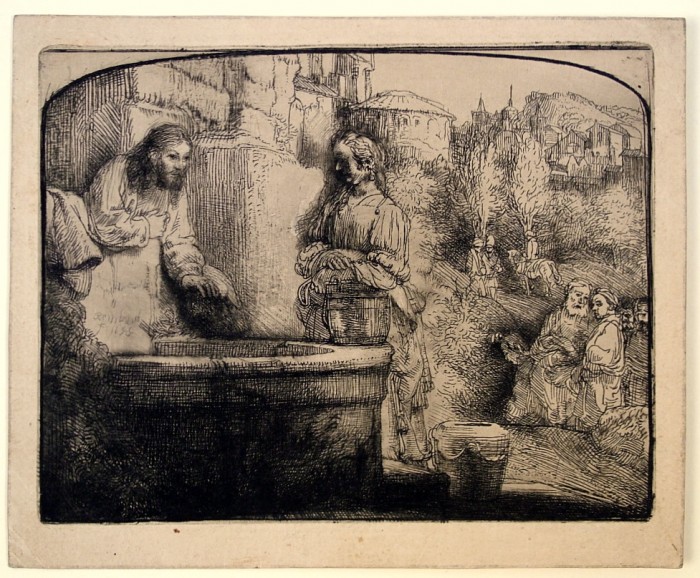Christ and the Woman of Samaria, 1657

Rembrandt Harmensz. van Rijn (1606-1669), Christ and the Woman of Samaria, 1657, etching, drypoint and burnishing, signed in the plate and dated (1658). References: White-Boon 70, Bartsch, Rovinski, Seidlitz 70; third state (of 3); Nowell Usticke 3e (of 5). Printed on a heavy ivory/tan gampi laminate Japan paper, in excellent condition, with margins, 4 7/8 x 6 3/16, the sheet 5 5/8 x 6 7/8 inches.
Provenance:
Collections of Carlos Gaa (cf. Lugt 538a), and the Kopping collection (according to sales records of C.G. Boerner, as described in sales in 1926 and 1929)
Richard Gutekunst, Stuttgart, London and Bern, 1870-1961 (Lugt 2213/a; stamp verso). The Gutekunst Collection was renowned for the quality of each and every one of its Rembrandt impressions.
A fine impression, with substantial burr on the well and the vines lower left, the faces of Christ and the woman, Christ’s hand, and elsewhere. In the third state Rembrandt burnished a number of areas including the upper right above Christ’s head, and the area between Christ and the woman; in this impression the burnishing marks are quite evident. There is a light veil of plate tone overall.
From about 1647 Rembrandt often favored for printmaking the heavy Japan paper available in Amsterdam through the Dutch East India Company; he used this very rare and expensive paper on many of his finest impressions, including this example.
In this state Rembrandt has darkened the lower left area of the composition and the well significantly with drypoint, added some definition to the stones of the well, lightened the area between Christ and the woman and the section above Christ’s head. In this impression the blackening of the lower left quadrant is particularly dramatic.
The woman of Samaria was amazed that Christ, a Jew, would speak to her as Jews traditionally stood quite apart from the Samaritans. He explains that “whomever drinketh of the water that I shall give him shall never thirst.” The woman was interested. Christ suggested she go and bring her husband, but she said she has no husband. Christ intuits that in fact she had five husbands, and that the present one is no true husband. The woman, impressed by this insight, declares that Christ must be a prophet. Christ’s disciples, who had gone into town to get some food, return (as seen at the right) and are amazed to find Christ involved in discussion with this woman. Christ proceeds to Galilee, noting that although this woman – from another land – was able to understand him, “a prophet hath no honour in his own country.”